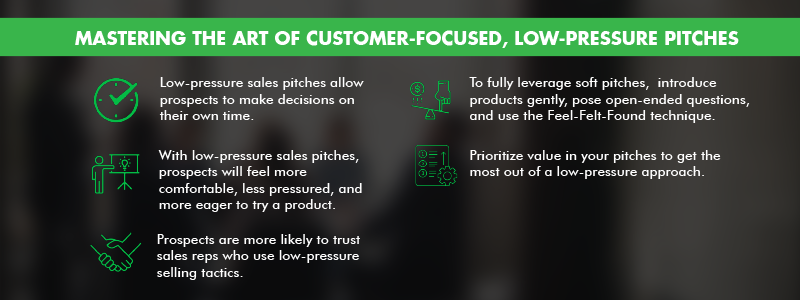Unlocking the Secrets of Successful Sales Managers
Developing these skills can help sales managers turn frustrating obstacles into opportunities for success.


Contrary to popular belief, most sales have little to do with a ’product’s superiority or a ’seller’s aggressiveness. Today’s consumer prefers to be informed about a particular product instead of being subjected to aggressive sales tactics. And that’s the key to low-pressure selling.
A low-pressure approach requires salespeople to act less like product pushers and more like advisors by educating prospects, gaining their trust, and building lasting relationships. It’s the complete opposite of old-fashioned, high-pressure selling, which too often leads to uncomfortable interactions and customer objections.
By prioritizing a non-aggressive approach, you can create an environment where customers feel empowered and in control of their decisions. This fosters a sense of trust and reduces the anxiety often associated with high-pressure sales.
It’s a valuable tactic if you’re looking to prioritize a customer-focused approach that builds long-lasting relationships. Yet, like all other sales processes, the low-pressure technique requires more than basic knowledge for successful implementation.
Continue reading to find out the best ways to effectively adopt a low-pressure approach in your business strategy.
A Dale Carnegie study shows that around 73% of people believe that trust is critical when building relationships with sales professionals. And it makes complete sense, considering that prospects are more likely to open up to a salesperson about their needs and desires if they trust them.
Building that trust is the focus of a low-pressure sales approach. It involves prioritizing your prospects’ needs and preferences, helping them understand how your product can address them, and allowing them ample time and space to make up their own minds. By combining this approach with open and honest communication, you can cultivate customer relationships that will last far beyond just one sale, fostering repeat purchases and achieving higher retention rates.
If your company has been wrangling with a sales slump for a while, it could be time to change tactics and give low-pressure selling a try. Here’s how:
Salespeople can lower the odds of encountering objections and seal more deals by focusing on a gentle approach when introducing products to prospects. The first rule is to start with a warm greeting that grabs attention and elicits comfort.
You should also use a soft tone with non-pushy phrases to introduce what you’re selling. Avoid words that may make you appear too pushy, like “you don’t want to miss out” or “this service is a must.”
Most importantly, respect your audience’s boundaries. If they seem genuinely disinterested, don’t keep pushing. You want to leave them with a good impression so they’ll be open to speaking with you about other products or services in the future. That’s the foundation of a good relationship.
A salesperson should always ask open-ended questions that encourage meaningful conversations. A good example is asking, “What do you expect from a product like ours?” This open-ended question encourages prospects to express their needs and preferences and gives you the chance to demonstrate how your product can address them.
Everyone wants to be heard, and the Feel-Felt-Found technique will help you listen to and understand your prospects. It’s one of the most effective tactics for handling sales objections.
With this technique, you acknowledge your prospect’s feelings and objections and relate them to the experiences of others who’ve been in a similar situation. You might, for example, share a story of a customer who felt the same way until they tried your product and experienced its benefits.
The other indispensable pillar of soft selling is prioritizing value to your potential customer. You want to make sure that prospects understand how your product or service can meet their unique needs. Instead of simply describing the product, you should try to draw attention to different features that specifically address your prospects’ pain points.
Finally, you need to understand that objections are inevitable, even when you’re employing a low-pressure approach. Techniques such as attentive listening and utilizing real-life examples can transform obstacles into opportunities, alleviating prospects’ concerns and enhancing the overall sales experience.
The advantages of adopting a low-pressure sales approach are extensive. By focusing on making your prospects feel at ease, you’ll be fostering an environment where they can explore and consider trying a product enthusiastically.
The effectiveness of low-pressure sales lies in building unwavering trust and credibility, which sets the stage for enduring relationships with clients. In this way, it’s not just a method, but a customer-centric philosophy that informs every aspect of the sales process, from prospecting through closing and follow-up. Remember, your focus isn’t on the deal, it’s on the client.
Whether you’re a small or large organization, adopting a low-pressure sales approach can help you build a wider, more loyal customer base. It’s not always easy, but the rewards are unparalleled. And MetaGrowth is here to help you navigate that path to success.
Partnering with MetaGrowth means gaining access to industry-leading experts who can help take your sales to the next level. We understand the nuances of low-pressure sales and can craft training programs that resonate with your organization’s unique dynamics, whether you’re hiring your first sales team or have a staff full of seasoned pros. Contact us today to kickstart your journey to a transformative sales approach!
Written by
Josh Hirsch
Developing these skills can help sales managers turn frustrating obstacles into opportunities for success.
As a sales manager, your success no longer hinges on smashing your own quotas. It’s about managing and
Roleplaying can be a valuable tool for helping your sales staff learn how to handle real-world situations.